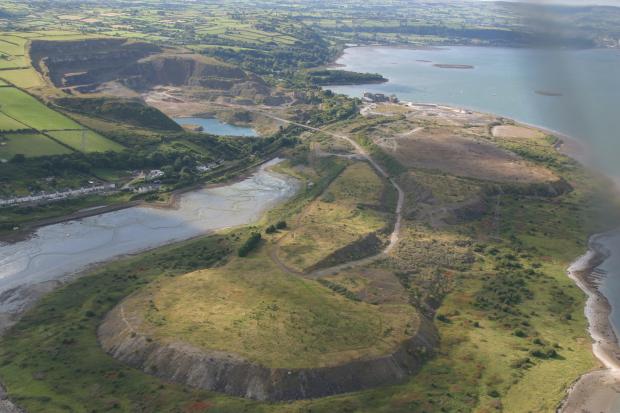
Larne Lough is a sea lough approximately 9 km long whose form was mainly determined in relation to the Larne Lough Fault, which runs in a north-northwest direction.
The upper Lough is approximately 2 km wide and comes to narrows at Barneys Point and Magheramorne Quarry, halfway along its length. At the Barneys Point and the White House, fossiliferous Jurassic rocks of planorbis zone age can be found. Notable recent sites, including estuarine clay series are also found at the narrows on the Quarry side. These clays contain fossil remnants of the Giant Irish Deer.
There are diverse habitats around the Lough ranging from an artificial brackish lagoon in the northwest to mudflats, rocky shores and saltmarshes throughout.
The brackish lagoon supports an unusual bryozoan community and open water macrophyte community including the rare species eelgrass) and spiral tasselweed.
Mudflats are located throughout the Lough, with the one at Old Church Bay being noted for the priapulid worm (Priapulus caudatus). At Barneys Point the turbid dynamic processes have resulted in the unusual formation of thick mats of the sponge Hymeniacidon sp. on the lower shore.
The saltmarshes, mainly in the upper Lough near Ballycarry, exhibit the complete zonation series from the transitional and lower saltmarsh community to upper saltmarsh communities. A number of rare plant species are found including lax-flowered sea-lavender, saltmarsh flat-sedge, spring squill, frosted orache and sea-purslane.
On Swan Island the nationally rare species bur chervil can be found in significant abundance.
Apart from the important breeding tern population at Swan Island, Larne Lough regularly supports nationally important numbers of overwintering birds including the goldeneye, great crested grebe, red-breasted merganser and shelduck. The waders greenshank and redshank are also present in nationally important numbers. Finally the common gull also breeds within the Lough in nationally important numbers.
The southern end of Lough Larne is important for the lght-bellied Bent goose, and internationally significant overwintering numbers have been recorded.
Related articles
- ASSI Guidance for Public Bodies/Competent Authorities
- Coastal Areas of Special Scientific Interest
- Conservation Management Plans (CMPs)
- European Marine Sites - Marine Special Areas of Conservation and Special Protection Areas
- International Year of the Salmon 2019
- Introduction to Conservation Management Plans (CMPs) for Northern Ireland’s Special Areas of Conservation
- Marine Conservation Zones
- Marine historic environment
- Marine Protected Areas
- Marine Ramsar sites
- Monitoring marine habitats and species
- Movanagher Fish Farm
- Portrush Coastal Zone
- River Bush Salmon Station
- Salmon Conservation
- Shipwrecks
- Special Areas of Conservation
- Special Areas of Conservation for Harbour porpoise
- Special Protection Areas
